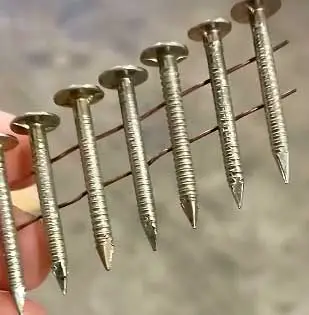Woodworking projects are incomplete without shank nails. A wide range of shanks is available. Ring shanks and smooth shanks are top choices for various types of woodworking.
But pros and cons are part and parcel of each shank.
Choosing a particular shank will give some benefits while compromising a few advantages for not picking the alternative option.
Here, we will go for in-depth details to check out the difference between ring shanks vs. smooth shanks.
A Quick Comparison Table
Want to learn quick details? You can glance over this comparison table to get an instant idea about both shank nails.
| Specifications | Ring Shank | Smooth Shank |
| Using purpose | Unique option | More common option |
| Holding condition | Twice holding power | Decent holding power |
| Sizing options | 2-inch to 9-inch | 2-inch to 6-inch |
| Ideal usage | Subflooring, underlayment, wall, and roof sheathing. | Basic framing applications and interior finish work |
| Withdrawal | Requires twice the withdrawal strength | Easy to pull out |
| Durability | More durable | Less durable |
| Cost | A slightly pricey | More affordable option |
Main Differences Between Ring Shank And Smooth Shank
Learning some technical things about shank nails is necessary to understand working ability thoroughly. Knowing some basic things may not be enough to select the right shank nails for your work.
Below are in-depth details about them.
- Using Purpose
Compared to ring shanks, smooth shanks are more common options. Most woodworkers use smooth shanks as you can easily use them for a wide range of wood surfaces.
- Holding Condition

Have you noticed the design of both ring and smooth shanks?
Smooth shanks have flat sides, while ring shanks feature round-shaped elevated sides.
Ring shanks have twice as holding power as smooth shanks.
When you put the round-shaped nails inside the woods, they stick to the woods more stiffly.
On the contrary, smooth shanks are perfect for everyday use and have enough holding power for regular woodworking tasks.
- Sizing Options
We need different-sized shanks based on the wood thickness level and working objective. Ring shanks are available from 2-inch to 9-inch, making them more versatile and effective in more heavy-duty woodworking projects.
In contrast, smooth shanks have sizing options from 2-inch to 6-inch. Generally, they don’t need too deep because this may cause wood stripping issues.
- Ideal Usage
Before choosing a particular shank, you must first decide where you are going to use it. Ring shanks are ideal for subflooring, underlayment, wall, and roof sheathing.
Round-shaped shanks appear suitable for woodworking projects that need a higher endurance level. This shank type can retain its stiffness on different wood surfaces to provide extra support. They are better for exterior areas.
Contrastly, smooth shank nails are ideal for basic framing applications and internal finish work. They can swiftly get into the internal area, whether it is hard or softwood.
- Removal

Considering its removal process is also important if you want to use particular shank nails for the short term.
Smooth shanks are generally easy to remove from most woods.
They don’t stick too hard to cause additional issues.
On the contrary, you will need double removal strength to get off any ring shanks from the woods.
If the wood is extremely hard and the size of ring shanks is more than 5 inches, using additional might be necessary to get your job done.
- Durability
Compared to smooth shanks, ring shanks are more durable. Round-shaped shanks can get into wood fibers more precisely and stay in a more stiff position.
As a result, extreme wind or cyclical moisture conditions can’t harm it.
In contrast, the holding strengths of smooth shanks may become weaker over time. This mainly happens when wood regularly expands and gets affected by excessive moisture.
- Holding Power
One of the main reasons to choose ring shank nails is their excellent holding power stemming from the spiraled shank design. As these nails are driven into a material, the rings scrape against the surrounding surface, creating more friction and grip. This allows ring shank nails to resist forces trying to pull them out.
Smooth shank nails, lacking these rings and protrusions, don’t “bite” the material in the same way. So while they can still provide decent holding power thanks to friction and their tapered shape, they are more prone to being worked loose over time.
Winner: Ring shank nails
- Ease of Driving
On the other hand, the smooth, angled shank of smooth shank nails allows them to slide into material with less resistance compared to ring shank nails. The sharp edges of ring shank protrusions scrape against the surrounding surface as they are driven in, requiring more force.
So when dealing with thick or hard materials, opting for smooth shanks makes the fastening process require less effort. This also reduces the risk of bending nails if inadvertently hit at slightly wrong angles.
Winner: Smooth shank nails
- Pull-Out Resistance
As touched on earlier, the gripping rings circling a ring shank nail’s body allows it to dig into the surrounding material, prevent slippage, and resist forces trying to pull it out. This makes properly driven ring shank nails extremely hard to dislodge, giving them excellent pull-out resistance.
Smooth shank nails, lacking these aggressive gripping features, are moderately resistant to being pulled out but can still work themselves loose more easily in comparison.
Winner: Ring shank nails
- Reusability
If you need to temporarily fasten something with the intention of removing the nails later on for reuse, smooth shank nails are the better choice. Because they don’t dig aggressively into materials like ring shank nails, they can be extracted and reused multiple times without compromising holding integrity as much.
Ring shank nails gripped tightly into a material can be difficult to remove fully intact for reuse. And if successful, the rings and shank are more likely to get damaged or deformed in the process.
- Cost
Both smooth shanks and ring shanks have almost the same price. But the average price of smooth shanks is a little bit lower per pound.
On the contrary, the starting price of ring shanks is slightly higher per pound. There might be a few versions that a more heavy-duty construction with a higher price tag.
Use Case Examples
Now that we’ve compared these options across several metrics, let’s see how that translates into real-world applications using some examples.
- Framing and Decking
For structural framing applications where exceptional holding power is needed, ring shank nails are the clear choice. Their unrivaled grip keeps frames rigidly secure despite expansion, contraction, or outside forces over time.

Smooth shank nails simply can’t provide the same long-lasting structural stability in framing scenarios dealing with wood movement, gravity, weather elements exposure, and more.
For decking applications prone to wood expansion/contraction and foot traffic vibrations, ring shank nails are also superior to smooth shanks for preventing loosening and squeaky boards over your deck’s lifetime.
The tight grip allows the wood to move minimally without compromising the fastener.
Winner: Ring shank nails
- Fencing and Lattice
Constructing wooden fences or lattices deals with less extreme wood movement compared to framing or decking. And these structures need to retain some flexibility.
So smooth shank nails provide sufficient holding power in fencing/lattice applications while still allowing the necessary flexibility as environmental conditions cause slight wood swelling, shrinking or warping over time. This flexibility prevents brittleness and cracks.
Ring shank nails would bite too aggressively, restricting natural movement and increasing the chance of damage. They’re overkill for these use cases.
Winner: Smooth shank nails
- Tile Underlayments
When fastening underlayments for tile, stone, or vinyl flooring, ring shank nails provide maximum grip to keep substrates firmly secured. This prevents cracks or loose spots in the finished flooring above due to movement below.
Smooth shank nails would be more prone to working themselves loose over time in this application.
Winner: Ring shank nails
What Will Be The Suitable Choice For Your Wood Project?

It mainly depends on the type of wood projects you are handling. Smooth shank nails seem okay if you use them for the internal area or any basic purpose.
In such a case, moisture and outside weather can’t cause any issues.
However, if you are working on heavy projects, especially for the outside area, using ring shanks is a practical option. Apart from ensuring long-lasting durability, they are not prone to come out from the wood over time.
Frequently Asked Questions (FAQs)
Compared to smooth shanks, ring shanks have double withdrawal strengths —they can stay inside the wood fibers more firmly for an extended time.
Though you can use smooth shanks for framing, ring shanks appear a better option due to their twice withdrawal strength —they won’t be affected by external conditions.
Ring shank nails are versatile for various wood or wood projects such as roofs, plywood, siding, decking, underlayment, subflooring, walls, etc.
Unlike regular shank nails, rings shank nails have 40% more gripping power. Though they may not hold as firmly as screws, you can still get close support.
Yes, you can use ring shank nails for roof sheathing since they can raise the uplift resistance and their extreme fastener capability.
Conclusion
Are you still wondering which one to choose, ring shanks vs. smooth shank?
You should not! We have outlined all the precise information about both shank nails to help you get a clear overview of them.
Ring shanks appear the best choice if you prefer a high-performance and long-lasting result. But smooth shanks are easier to work with and ideal for regular woodworking tasks.
